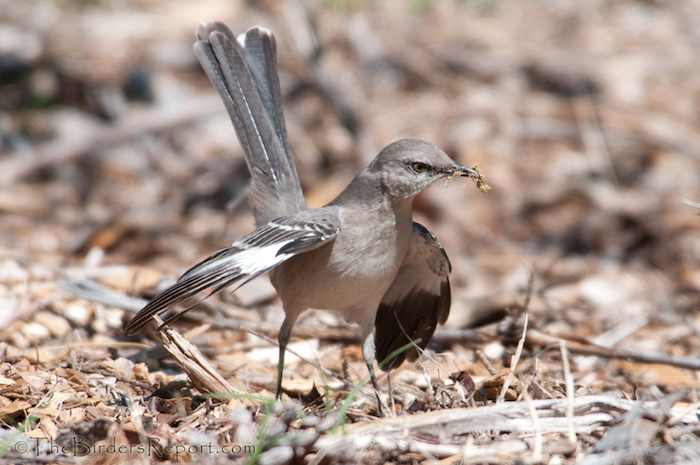
You’ve heard them. Maybe in the day, maybe all day. Maybe at night, when it seems decent creatures should be in bed. Maybe they’ve added sweet melody to your spring morning. Maybe they’ve kept you wondering at night. Northern Mockingbirds are singers.
They have their own style of delivery, but Mimus polyglottos, the many-tongued mimics, learn their songs from other birds, animals, and even machines around them. They sing their playlists round and round, a wheel of chirps, chortles, squawks and trills that dominate the local soundwaves. With age and experience, they keep learning new songs. Males, the louder and more relentless singers, may learn up to 200 songs in their lives. Their musical variety, then, can attract long-term mates who know that they have been around and have the stuff to survive.
The trilling you’ve heard through the night is usually a less satisfied bird, a lovelorn bachelor still seeking someone to nest with.
Mockingbirds’ feathers seem less flamboyant than their songs, but they hold their own surprises. Wings folded, the birds are nondescript tan and gray, as unremarkable as newsprint. But then, when the birds fly, bold black-and-white abruptly flashes out on wings and tail, a sort of optical shout, like a meaningful story. Then the birds land and go visually mute once more, like a pause for thought.
Dull colors might seem like useful camouflage, but mockingbirds don’t settle for dull. Even standing on the ground they frequently flash their wings out. The standard explanation for this display is that the bright white wing patches startle bugs, causing them to move and be more easily seen and eaten. But this effect is unobserved. Test it, with, say, a small piece of paper. Do bugs move when you flash it at them? Apparently other species of mockingbirds who lack the bright patches also flash their wings. So it seems the biggest known effect of flashing wing patches is to make people wonder why they do it.
As forward as these birds can be with just borrowed songs and black-and-whites, mockingbirds are no less shy in tending their territories. They dive-bomb cats, dogs, and crows who wander too near. Less riskily, with encroachments from their own kind males have developed a bill-up and chest-to-chest dance at their territorial border. That ritual rarely deteriorates into a pecking battle, and allows both birds to make peace and move on without too much loss or humiliation.
The successful male mockingbird chooses a nesting site. Several of them, actually, where he frames several nests of twigs. Then the female makes her choice, and finishes the one she’ll use with grasses and other soft linings. She lays a handful of eggs, which in 12-13 days hatch into blind, naked nestlings. Both parents help the young into their first feathers, and then she will often start a second brood while he continues to tend the first.
In the 19th century, before radios or today’s Pandora, mockingbirds were captured to provide music in people’s homes. Those nearly year-round singers—the literature lists them as singing February to August, and then again September to November—were so popularly caged that they began to disappear from East Coast yards. Since then they have rebounded, doing well in suburbia’s mix of open areas and trees with fruits and berries. Now, in the era of expanded pesticide use and domestic cats, they are declining again, but their song remains the headline show in gardens across America.
